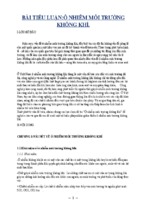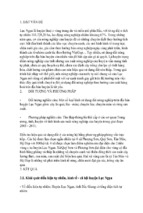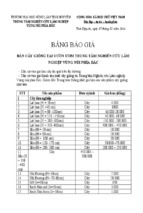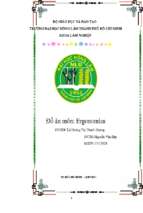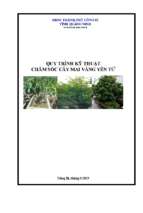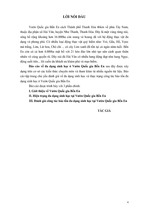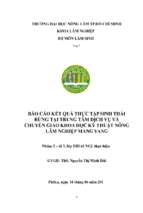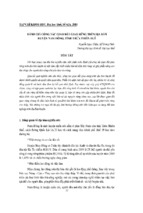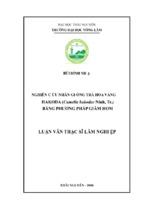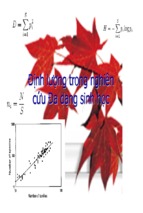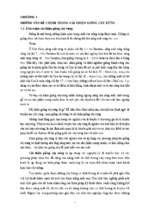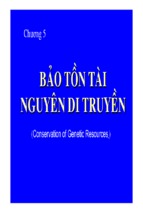Helvetas Vietnam – Swiss Association for International Cooperation
ETSP – Extension and Training Support Project for Forestry and Agriculture in the Uplands
218 Doi Can Street, GPO Box 81, Hanoi, Vietnam; phone: +84 4 832 98 33, fax: +84 4 832 98 34
e-mail:
[email protected]
web site ETSP: http://www.etsp.org.vn, web site Helvetas Vietnam: http://www.helvetas.org.vn
Ministry of Agriculture and Rural Development
Forestry Department (MARD)
Forest Sector Support Program and Partnership (FSSP-P)
Result Area No. 8
Extension and Training Support Project (ETSP)
Forestry Research, Education, Training and Extension
(RETE)
Situation Analysis, Needs Assessment and
Recommendations for the
National Forestry Strategy 2006 to 2020
Final Draft
(RETE_EN_final draft_Sept2005.doc/pdf)
Ha Noi, September 01, 2005
i
Acknowledgements
This study was undertaken by Mr Doan Diem1 and Mr Edwin Shanks2 (consultants), together
with Mr Nguyen The Bach3, Coordinator of the Extension and Training Support Project
(ETSP, http://www.etsp.org.vn).
The authors would like to thank the many people who have participated in the study. This
includes members of the Reference Group including representatives from the MARD
Forestry Department, Organization and Personnel Department, Science and Technology
Department, National Extension Center, Forest Sciences Institute, Forest Inventory and
Planning Institute, Management Training School No. 1 and Xuan Mai Forestry University.
Our thanks are also extended to the representatives of the province extension centers, forestry
training schools, universities, and research centers whom we visited and who made such
valuable contributions to the study (these organizations are listed in the Introduction Section).
Our particular thanks are extended to Mr Pierre-Yves Suter (Chief Technical Adviser to
ETSP) who provided essential guidance and inputs throughout the study, and to Ms Nguyen
Kim Phuong and Ms Nguyen Thu Thuy from the ETSP office who provided kind and
valuable assistance on the field work visits.
1
Email:
[email protected]
Email:
[email protected]
3
Email:
[email protected]
2
ii
Abbreviations
CPV
EFA
DAES
DARD
ETSP
FD
FDI
FIPI
FPD
FMB
FSIV
FSSP&P
GSO
HRD
ITTO
MARD
MOET
MOLISA
MPI
NAEC
NGO
NTFP
ODA
OPD
PAEAC
PAEC
PFPD
PPA
Program 661
RETE
SFE
SFSP
SME
VHLSS
WTO
Communist Party of Vietnam
Education for All Action Plan (2003)
District Agricultural Extension Station
Department for Agriculture and Rural Development
Extension and Training Support Project for Upland Agriculture and Forestry
Forestry Department
Foreign Direct Investment
Forest Inventory and Planning Institute
Forest Protection Department
Forest Management Board
Forest Sciences Institute of Vietnam
Forest Sector Support Program & Partnership
Government Statistics Office
Human Resources Development
International Tropical Timber Organization
Ministry of Agriculture and Rural Development
Ministry of Education and Training
Ministry of Labour, Invalids and Social Affairs
Ministry of Planning and Investment
National Agricultural Extension Centre
Non-Governmental Organization
Non-Timber Forest Products
Official Development Assistance
Organization and Personnel Department
Provincial Agricultural Extension Advisory Council
Province Agriculture Extension Centre
Province Forest Protection Sub-Department
Participatory Poverty Assessment
Five Million Hectares Afforestation Program
Research, Education, Training and Extension
State Forest Enterprise
Social Forestry Support Program
Small- and Medium Sized Enterprise
Vietnam Household and Living Standards Survey
World Trade Organization
iii
List of Contents
Acknowledgements ......................................................................................................................... i
Abbreviations................................................................................................................................. ii
List of Contents............................................................................................................................. iii
Executive Summary........................................................................................................................1
1. Introduction.............................................................................................................................6
1.1 Scope and objectives of the study ..............................................................................................6
1.2 Participants and fieldwork..........................................................................................................7
1.3 Introduction to forestry RETE in Vietnam.................................................................................8
1.4 Stakeholder groups and analytical approach ..............................................................................9
1.5 Content of the report ................................................................................................................10
2. Sector development trends and challenges for RETE .......................................................12
2.1 Strategic objectives of the sector..............................................................................................12
2.2 Global integration and national priorities.................................................................................12
2.3 The production sub-sectors ......................................................................................................13
2.3.1 Rapid growth in the wood processing sub-sector ............................................................14
2.3.2 Future directions in the plantation economy ...................................................................15
2.3.3 Craft villages in the forest production and processing economy.....................................16
2.4 Forest protection, co-management and benefit-sharing ...........................................................16
2.4.1 Multiple-use forest management systems for protection forest areas..............................17
2.4.2 Local participation in bio-diversity conservation ............................................................18
2.4.3 Environmental services....................................................................................................19
3. Human resource development priorities.............................................................................20
3.1 Current situation and main challenges in HRD........................................................................20
3.2 Encouraging new recruits into the sector .................................................................................21
3.3 Upgrading the knowledge and skills of in-service staff ...........................................................22
3.4 Forestry laborer training...........................................................................................................23
3.5 Increasing the contingent and capacity of forestry extension workers.....................................24
3.6 Improving the capacity of forestry researchers, educators and trainers ...................................25
4. RETE linkages and network analysis .................................................................................27
4.1 Overall considerations..............................................................................................................27
4.1.1 Building on formal and informal linkages.......................................................................27
4.1.2 Factors of supply and demand in the provision of RETE services ..................................28
4.1.3 Patterns of increasing diversification of services at the local level .................................28
4.2 Main strengths and weaknesses in the system..........................................................................30
4.2.1 Linkages within the education and training system.........................................................30
4.2.2 Linkages between forestry research and other parts of the system..................................31
4.2.3 Linkages with the province training schools and extension systems...............................32
4.2.4 Linkages with the forest production and processing sub-sectors ....................................33
4.2.5 Linkages with the SFEs and Forest Management Boards ...............................................33
4.3 Institutional constraints ............................................................................................................34
4.3.1 Investment in science, technology and training...............................................................34
4.3.2 Planning and financing constraints..................................................................................35
5. Solutions and Recommendations.........................................................................................37
5.1 Overall vision and strategy.......................................................................................................37
5.1.1 Sub-program objectives...................................................................................................37
5.2 Measures to improve the integration, relevance and effectiveness of RETE ...........................39
5.2.1 Promoting practical networking arrangements ................................................................39
5.2.2 Promoting institutional partnerships................................................................................41
5.2.3 Enhancing the demand-driven approach to forestry research..........................................42
5.2.4 Strengthening the education and training system ............................................................44
iv
5.2.5
5.2.6
Building capacities in forestry extension.........................................................................45
Financing and cost-norms................................................................................................47
Annex 1 Description of the RETE system..........................................................................................49
Annex 2 Guiding questions used in the fieldwork..............................................................................56
Annex 3 Terms of Reference for the Study ........................................................................................58
Annex 4 Examples of traditional forest industries in transition .........................................................62
1
Executive Summary
The aim of this study is to provide an analytical foundation for development of a shared
vision and strategy for future Research, Education, Training and Extension (RETE) in the
forestry sector in Vietnam. The study has been carried out as one of the main activities and
outputs of the Forest Sector Support Program and Partnership (FSSP) Action Plan for 2004
(Collaborative Action D1), and it has been supported by the Extension and Training Support
Project (ETSP) under the Forestry Department (FD) of MARD.
The specific objectives of the study are as follows:
1. To undertake a situation analysis and needs assessment of research, education, training
and extension in the forestry sector together with key stakeholders and service providers
at national, regional and provincial levels;
2. To make recommendations for steps that can be taken to enhance the complementarity
and integration between the forestry research, education, training and extension subsectors and to improve the collaborative linkages between RETE organizations;
3. To provide an input to the formulation of the new National Forestry Strategy for the
period 2006 to 2020, particularly with respect to the priorities for Human Resources
Development (HRD).
The Situation Analysis and Needs Assessment begins in Section 2 by highlighting some of
the major development trends in the forestry sector and challenges for the future National
Forestry Strategy (2006-2020). And it assesses the implications of these challenges for the
forestry research, education, training and extension system. This is no means a fully
comprehensive sector analysis. Rather, the aim here is to identify issues that have particular
relevance for Human Resources Development with respect to the professional knowledge and
skills that will be required by forestry planners, managers, technicians, researchers, trainers
and forest producers etc. in the coming years. These HRD priorities for the National Forestry
Strategy are examined in detail in Section 3 and can be summarized as follows:
• First, how to maintain a sufficient number and quality of new recruits coming into the
sector at professional technical and degree course levels, particularly for the forest
production and protection sub-sectors;
• Second, how to upgrade the knowledge and skills of the large number of existing
professional staff in the localities and in different agencies including, particularly, staff
of the FPD, SFEs and local administrations;
• Third, how to provide effective vocational training for the large numbers of forestry
workers (mostly untrained farmers) on the scale required to meet the target set by the
CPV Central Committee of having 25% of trained workers by 2010 and 50% by 2020;
• Fourth, how to increase the number and capacities of forestry extension workers on the
ground, particularly in forest-dependent areas (districts and communes) in the uplands;
• Fifth, how to up-grade the qualifications, skills and capacities of staff of the forestry
researchers, educators and trainers so they are able to adequately support these efforts
and to improve the quality of education and training.
Section 4 then provides an analysis of the strengths and weaknesses in the existing
(horizontal and vertical) linkages between the different RETE Service Providers and RETE
2
Client Groups. This looks at both the formal (institutional) and informal aspects of these
linkages in the system, as assesses factors of ‘supply’ and ‘demand’ in the provision of these
services. Leading on from this, Section 4 also makes an assessment of the regulatory
framework in the current Forest Development Strategy (2002-2010), and it identifies a
number of institutional constraints that influence the extent that RETE organizations can
effectively collaborate. In particular, a number of critical investment and financing
constraints are identified, and solutions to these constraints are proposed.
Section 5 makes proposals for the future vision and main strategic directions of the RETE
system in the new National Forestry Strategy, together with a set of concrete
recommendations for how to improve the organizational linkages, integration and
complementarity between the sub-sectors. These proposals are formulated in such a way that
they could form a collaborative program of activities that could be adopted and financed
through the FSSP and/or by specific forestry projects.
The proposed long-term vision is as follows:
RETE Vision 2020: To improve the quality and efficiency of forestry training
and education, extension, and science and technology based on future needs, to
develop the human resources with high quality for the sector, and to link research
activities, training and extension with forestry businesses, in order to fulfil
national development objectives (towards industrialization and modernization of
the sector) and implementation of the National Forestry Strategy 2006-2020. The
special focus is on the forest sector’s contribution, both direct and indirect, to the
national economy, environmental protection, and achieving better living standards
for forest-dependent people.
The proposed main strategic priorities of the RETE sub-programs are as follows:
Research sub-program
• Finalize the forestry research strategy for 2006-2020 on the basis of MARD’s National
Forestry Development Strategy for 2006-2020.
• Concentrate more on demand-driven research projects that help those farmers involved
in forest management and protection to support themselves with the income derived
from forestry-related production and employment.
• Conduct more research on sustainable plantation and natural forest management, with a
strong focus on selected industrial plantations that have commercial high-yield crops
for export and domestic consumption purposes. To put more investment into
technology to ensure the supply of 90% of wood for local consumption and 80% for
export by 2020.
• Improve processing technologies and facilities, support small-scale and industrial
processing enterprises to find new domestic and export markets, and enhance the
competitive advantages of the forest industries with respect to international integration.
• Enhance research capacities and facilities, adopt improved research approaches that
integrate more fully with training and extension, and develop human resources for
effective implementation of forest sector development programs.
• Align research institutes, forestry extension and training schools with forestry-related
businesses and production establishments.
3
• Provide the scientific basis for development of policies that serve essential needs for
the forest sector (in the socialization of forestry sector, development of a stable forest
area, environmental values etc.).
• Enhance international collaboration in order to improve the capacity of researchers and
to transfer technologies especially in high yielding plantations.
Forestry extension sub-program
• Provide forest-dependent farmers and communities with technical know-how necessary
to make their own agro-forestry business plans, to apply advanced technologies to
improve productivity, forest quality, environmental and ecological protection, thus
resulting in better living standards for forest-dependent people.
• Introduce special forestry extension measures for forest-dependent communities
(communes, villages and population groups) that have large forest areas, through
community forestry management practices, farm forestry and market development.
• Enhance the socialization of agriculture and forestry extension.
• Increase the contingent and capacity for forestry extension workers at the grass-roots
level systematically to assist farmers, particularly those in forest-dependent areas.
• Improve forestry extension methods, develop and update training curricula, and focus
more on short-term training courses that farmers can afford and grasp; module-based
training must be standardized. The content of extension work should focus on forest
plantations, natural forest management, processing, product trading and agro-forestry.
• Link forestry extension agencies, research centers and farmers to forestry-related
businesses and production units.
• Coordinate and disseminate more widely the many existing extension and training
methods and materials that are already developed by different RETE organizations and
projects.
• Help to create closer linkages between management staff, researchers, businesses and
producers.
• Provide vocational and advanced trainings for traditional wood processing and craft
villages in order to maintain and increase the quality of the products to meet the
increasing demand of both, domestic and international markets.
Education and training sub-program
• Change comprehensively the training system including the structure, curricula, content,
teaching methods and management mechanisms to improve training quality. Focus on
short-course modules for farmers, enterprise workers and craft villages, and refresher
training for in-service staff, especially with policies to give incentives for staff working
in remote areas.
• Provide formal trainings for around 10’000 students/year (of which 160 are post
graduates, 1’650 graduates, 900 from colleges, 1’900 mainly from technical training
schools and 5’100 from vocational training schools).
• Increase the number of trained workers in the sector to 25% by 2010 and 50% by 2020
by delivering high-quality training services driven by market demands, and focus more
on short-term training courses (with an annual increase of 80%).
4
• Strengthen the socialization of training.
• Meet the sectoral requirements in the international integration process. Encourage them
to study and undertake research by themselves, build up their practical experience, to
learn foreign languages and computer skills.
• Clarify and strengthen the respective tasks and functions of the different forestry
education and training organizations, with respect to their major target groups,
standardized curricula, and provision of regular and contract-based training services.
• Enhance the linkages between the forestry training schools and the provincial training
schools and extension system at province, district and commune levels.
• Enhance international collaboration in forestry education and training, and access to
advanced training standards of the world, with some institutions achieving international
standards in the forest sector by the year 2015.
The main recommendations for improving the linkages, integration and complementarity
between the RETE sub-sectors and organizations are as follows:
1.
Establish stronger networking arrangements between RETE organizations that focus on
fulfilling practical tasks and assignments related to implementation of the National
Forest Strategy, and which have clear benefits for each participating organization.
2.
Encourage the formation of more intensive ‘institutional partnerships’ and ‘twinning
arrangements’ between RETE organizations (research, education and training centers)
and forestry production, protection and processing units.
3.
Encourage the further development of specialized ‘research and development units’ and
‘training service centers’ under RETE organizations that provide out-reach services, but
only in such a way that will not lead to institutional fragmentation.
4.
Develop policies and mechanisms to encourage a wider set of private sector agencies and
socio-economic organizations to become more actively involved in forestry research,
training and socialization of extension services.
5.
For the forestry research system – establish mechanisms and clear guidelines (‘codes-ofpractice’) to ensure that the strategic direction and content of research is based on wellinformed assessments of demand, and that there is effective follow-up and dissemination
of results.
6.
For the education and training system – clarify and strengthen the respective tasks and
functions of the different forestry education and training organizations with respect to
their major target groups, updated and standardized curricula, and provision of regular
and contract-based training services.
7.
Concentrate on developing modular-based training systems and courses that can be
utilized in different training contexts (as part of regular training programs and for shortcourse / in-service training), which are jointly prepared by different RETE organizations,
and which provide the focal point for up-dating curricula nationwide.
8.
For the extension system – strengthen the contingent and capacity of forestry extension
at all levels, but particularly to increase the number and skills of forestry extension staff
working in forest-dependent rural areas in the uplands.
9.
In the longer term perspective, move towards more integrated forms of in-service
training and extension training that utilize modern Information Communications
5
Technology, mass media channels, and the development of distance learning systems in
order to obtain the required out-reach.
10. Revise and up-date the system of cost-norms for research, training and extension
activities to reflect current sector priorities, current costs for different types of work, and
to provide better incentives for people to work in remote forest areas in particular.
6
1. Introduction
1.1 Scope and objectives of the study
The aim of this study is to provide an analytical foundation for development of a shared
vision and strategy for future Research, Education, Training and Extension (RETE) in the
forestry sector in Vietnam. The study has been carried out as one of the main activities and
outputs of the Forest Sector Support Program and Partnership (FSSP) Action Plan for 2004
(Collaborative Action D1), and it has been supported by the Extension and Training Support
Project (ETSP) under the Forestry Department (FD) of MARD.
The specific objectives of the study are as follows:
1.
To undertake a situation analysis and needs assessment of research, education, training
and extension in the forestry sector together with key stakeholders and service providers
at national, regional and provincial levels;
2.
To make recommendations for steps that can be taken to enhance the complementarity
and integration between the forestry research, education, training and extension subsectors and to improve the collaborative linkages between RETE organizations;
3.
To provide an input to the formulation of the new National Forestry Strategy for the
period 2006 to 2020, particularly with respect to the priorities for Human Resources
Development (HRD).
At the outset, it should be noted that the report concentrates on identifying broad strategic
issues and opportunities, rather than going in detail into the specific requirements within each
RETE sub-sector. The authors also assume that readers have prior understanding of the
organization, policies and programs of the forestry sector in Vietnam. Accordingly, in order
to keep the report to a manageable size, we do not give a lot of detailed background
information in the report. Reference can be made to resource documents and an outline of the
RETE system given in Annex 1.
The report takes into account the provisions and new directions set out in the new Law on
Forest Protection and Development passed by the National Assembly in December 20044.
Reference is also made to Decree No. 565 from April 2005 on agriculture and fisheries
promotion, which provides the framework for future development of the extension system in
Vietnam. Reference can also be made to the draft Forestry Research Strategy6 which is
currently under formulation, and to the submission on the proposed re-organization of the
science and technology system under MARD7; these documents give more details on the
current situation and proposed future directions in the forestry research system.
4
Order No.25/2005/L-CTN (dated 14 December 2004) of the President promulgating the Law on Forest
Protection and Development.
5
Decree No.56/2005/ND-CP (dated 26 April 2005) of the Government on agriculture promotion and fisheries
promotion.
6
MARD. 2004. Vietnam Forestry Research Strategy to 2020 (Draft).
7
MARD. 2004. Submission to the Prime Minister on proposal for reorganization of the science and technology
system under MARD.
7
1.2 Participants and fieldwork
In conducting the study we have strived to adopt a consultative approach at all stages, and the
report incorporates the ideas and suggestions given by a large number of people from a range
RETE organizations nationwide and at different levels.
The concept of the study and Terms of Reference were initially shared and discussed with
FSSP Partners, and approved by the FSSP Technical Executive Committee in January 2004.
The scope and objectives of the study were then further refined together with a Reference
Group consisting of representatives from the key departments of MARD and national RETE
organizations including:
•
•
•
•
•
•
•
•
Forestry Department
Organization and Personnel Department
Science and Technology Department
National Extension Center
Forest Sciences Institute (FSIV)
Forest Inventory and Planning Institute (FIPI)
Management Training School No. 1
Xuan Mai Forestry University.
In the early discussions held with the Reference Group, it was recommended by the group
that the study should concentrate mainly on how to improve the linkages between the RETE
sub-sectors and organizations, with a view to improving the complementarity, relevance and
impact of forestry research, education, training and extension. Accordingly, the fieldwork and
analysis made in this report focuses on this particular set of issues.
The study involved a series of field-visits in the north and south of the country and meetings
with leaders and staff from a range of RETE organizations (the guiding questions used in
these discussions are given in Annex 2). These organizations include:
•
•
•
•
•
•
•
•
•
•
•
•
•
•
Province Extension Centre, Lang Son Province
Province Extension Centre, Quang Ninh Province
Province Extension Centre, Dong Nai Province
Management Training School No. 1 (Ha Noi)
Management Training School No. 2 (Ho Chi Minh City)
Forest Sciences Institute Sub-centre (Ho Chi Minh City)
Forest Inventory and Planning Sub-Institute (Ho Chi Minh City)
Central Forestry High School No. 1 (Quang Ninh)
Central Forestry High School No. 2 (Dong Nai)
Technical Vocational School No. 1 (Lang Son)
Technical Vocational School No. 3 (Binh Duong)
Central Vocational School for Wood Processing (Ha Nam)
Xuan Mai Forestry University
A joint meeting in Ha Noi with staff from the Faculties of Agriculture and Forestry
from Tay Nguyen, Thu Duc, Thai Nguyen and Hue Universities.
• Meetings in Ha Noi with representatives from donors/NGOs and projects involved
in FSSP (Result Area 8) and following-up meetings with MARD departments.
8
The fieldwork for the study concentrated mainly on visiting the Forestry High Schools,
Technical Vocational Schools and research sub-centers because, in general, there has been
less consultation with these particular RETE stakeholders in previous studies.
With respect to extension, on the other hand, there have been several surveys undertaken with
farmers and local communities in different parts of the country in recent years. These include:
(i) a detailed survey of extension needs amongst poor groups undertaken by the NGO
working group on extension8; (ii) a farmer needs survey undertaken by the MARD Public
Administration Reform Project9; and (iii) the Participatory Poverty Assessments (PPAs)
undertaken in 7 regions of the country as part of the Vietnam Poverty Assessment for 200210.
These studies provide in-depth analysis of extension and training needs and priorities, which
also provide a background for our study.
All the meetings and discussions held during the study were highly stimulating and
productive. It is the sincere hope of the authors that the report accurately documents the ideas
and suggestions of the participants, and reflects consensus viewpoints in a coherent manner.
At the same time, the report puts forward a number of observations and ideas specifically
from the authors, particularly with respect to long-term strategic options for how to improve
the quality and effectiveness of forestry research, education, training and extension services.
These are tabled as ‘options for discussion’ rather than as firm recommendations in the spirit
of promoting active discussion on the best way to move forward.
1.3 Introduction to forestry RETE in Vietnam
For the purpose of this study, the following functional definitions of research, education,
training and extension are used:
RESEARCH.
•
The research conducted by the FSIV and FIPI and their regional and
disciplinary sub-centers, and by the Forestry Universities, is mainly applied research but
also includes elements of basic research. Applied research focuses on the development of
forest technologies (e.g. seed multiplication and silviculture systems), forest land use
planning methods, and studies on policy applications and socio-economics etc. Another
type of research, which is commonly carried-out by the forestry education and training
organizations, includes demonstration plots and field trials that are used for both
teaching purposes as well as testing species and technologies in the field.
•
EDUCATION. This refers to formal full-time education programs lasting one or more
years which lead to: (i) vocational qualifications as provided by the Forestry Technical
Vocational Schools under MARD and the Provincial Agriculture and Forestry Schools; (ii)
technical qualifications as provided by the Central Forestry High Schools; (iii) diploma
and degree qualifications as provided by the Forestry University and Agriculture and
Forestry Colleges of the regional universities; and (iv) post-graduate degree
qualifications as provided by the Forestry Universities and FSIV. As defined by law the
8
NGO Working Group. 2005. Agricultural extension services for the poor: ethnic minority and gender issues in
agricultural extension. NGO sub-group on agricultural extension for the poor.
9
Public Administration Reform Project. 2002. Farmer Needs Study. Public Administration Reform Project
(VIE/98/004), Ministry of Agriculture and Rural Development, Hanoi.
10
See the PPA reports from: Ha Giang, Nghe An, Quang Tri, Dak Lak, Ben Tre, Lao Cai, Ninh Thuan, Hai
Duong and Ha Tay provinces (published by the Poverty Task Force in 2003).
9
higher education institutions can issue certificate for the lower training institutions; for
example, universities for colleges and for the technical vocational training schools. This
also includes part-time degree programs (Continuing Education) that are provided to upgrade the formal qualifications of in-service staff from province, district and increasingly
commune levels and which are provided in the provinces.
•
TRAINING. This is a broad category that includes a range of different types of formal
and non-formal training, including: (i) certificate training courses directly provided by
training institutions under DOLISA (according to Circular No. 65 dated 02/07/2004); (ii)
re-fresher short courses as provided by MARD through the budget for re-fresher training
for in-service staff (for instance, as allocated to the Management Schools and other training
organizations); and (iii) non-formal training courses provided by development projects
and programs and other agencies for managers, extension workers and farmers etc.
•
EXTENSION: As applied in the Government extension system this generally includes a
combination of: (i) farmer demonstration models; (ii) extension worker / farmer
training; (iii) formation of farmer groups or extension clubs; combined with (iv) support
for input supplies. A wider range of ‘farmer-to-farmer’ or ‘farmer-led’ extension
methods and approaches are promoted by many donor/NGO supported projects.
Many RETE organizations and development projects also promote methodologies that span
the divide between these sub-sectors. This includes the farmer field schools (FFS) approach
that was first introduced through the Integrated Pest Management Program, which aims to
integrate extension with training and hands-on applied research carried out jointly by farmers
and technicians. Recently, this approach has been extended to the forestry sector, for instance
in forest management field schools promoted by several projects. Also included are
methods such as participatory technology development (PTD) and market analysis and
development (MAD) that have been introduced by a number of forestry projects and
research centers in recent years. These types of collaborative action research and extension
are conducted in a development context together with forest farmers and local communities.
1.4 Stakeholder groups and analytical approach
The study uses a method of institutional and social network analysis11 in order to examine the
interactions and linkages between the different stakeholders involved in forestry research,
education, training and extension (see Figure 1 and Section 3). Figure 1 shows that in
addition to the main RETE organizations (listed in Annex 1) there is a wide range of other
stakeholders involved in these activities. These stakeholders can be broadly categorized into
RETE Service Providers (i.e. research, education, training and extension organizations) and
a number of RETE Client Groups (including local government administrations, forest
producers, State Forest Enterprises, grassroots extension workers, forest industries, and forest
farmers etc.).
This is not a hard-and-fast categorization, since some stakeholders (such as the Province
Extension Centers and District Extension Stations) are in practice both ‘service providers’ as
well as being ‘clients’ of the research, education and training system. Similarly, development
11
Davies, Rick. 2003. Network Perspectives in the Evaluation of Development Intervention. Paper for the
Conference on New Directions in Impact Assessment for Development, EDAIS, November 2003.
10
projects supported by donors and NGOs draw on the services of research and training
organizations, as well being involved in supporting the delivery of RETE services on the
ground. Nonetheless, this framework does help us to analyze the strengths and weaknesses in
the horizontal linkages between the RETE Service Providers, and in the vertical linkages
with the various RETE Client Groups.
1.5 Content of the report
Following this introduction, the report is divided into three main sections. The Situation
Analysis and Needs Assessment begins in Section 2 by highlighting some of the major
development trends in the forestry sector and challenges for the future National Forestry
Strategy (2006-2020). And it assesses the implications of these challenges for the forestry
research, education, training and extension system. This is no means a fully comprehensive
sector analysis. Rather, the aim here is to identify issues that have particular relevance for
HRD with respect to the professional knowledge and skills that will be required by forestry
planners, managers, technicians, researchers, trainers and forest producers etc. in the coming
years. These HRD priorities and examined in detail in Section 3.
Section 4 then provides an analysis of the strengths and weaknesses in the existing
(horizontal and vertical) linkages between the different RETE Service Providers and Client
Groups. This looks at both the institutional (formal) and informal aspects of these linkages in
the system, as assesses factors of ‘supply’ and ‘demand’ in the provision of these services.
Leading on from this, Section 3 also makes an assessment of the regulatory framework in the
current Forest Development Strategy (2002-2010), and it identifies a number of institutional
constraints that influence the extent that RETE organizations can effectively collaborate. In
particular, a number of critical investment and financing constraints are identified, and
solutions to these constraints are proposed.
Finally, Section 5 makes proposals for the future vision and main strategic directions of the
RETE system in the new National Forestry Strategy, together with a set of concrete
recommendations for how to improve the organizational linkages, integration and
complementarity between the sub-sectors. These proposals are formulated in such a way that
they could form a collaborative program of activities that could be adopted and financed
through the FSSP and/or by specific forestry projects.
11
Figure 1 Schematic View of RETE ‘Service Providers’ and ‘Client Groups’
HORIZONTAL LINKAGES
Extension
Administration
•
•
•
•
•
MARD:
FD
FPD
OPD
STD…
• National Extension
Centre (NEC)
• Other departments
of MARD
• PPC
• DARD
• Province Extension
Centres
• DPC
• ARDS
• District Extension
Stations
• CPC
• Other sections
doing extension
Education & Training
•
•
•
•
•
Management Schools (2)
Forestry University (1)
Forestry High Schools (3)
Tech. Vocational Schools (5)
Service centers under training
organizations
Research
Others
• FSIV
• FIPI
• Regional research
sub-centers
• Disciplinary Research
sub-centers
• International
organizations (e.g.
ICRAF,
RECOFTC)
• University Colleges of
Agriculture and Forestry (Tay
Nguyen, Thu Duc, Hue and
Thai Nguyen) under MOET
• Other research &
development
companies / centres
(e.g. seed, paper)
i
• Province Agriculture and
Forestry Schools & other PTIs
• Province adaptive
research centres
• Donors & INGOs
• Associations
• Private sector
services
• Media agencies
• Development
projects
R.E.T.E. CLIENT GROUPS
Government
agencies
Forest
Protection
units
SFEs and
FMBs
Grassroots
extension
workers
Forest
industries
&
companies
Household /
small-scale
enterprises
Forest
producers
Forest
dependent
communities
VERTICAL LINKAGES
R.E.T.E. SERVICE PROVIDERS
12
2. Sector development trends and challenges for RETE
2.1 Strategic objectives of the sector
The forestry sector in Vietnam is given three broad strategic objectives:
• An Economic Development Objective, which focuses on fostering commercial tree
growing including farm-forestry and industrial plantations, the development of mixed
forestry-agricultural farming systems, and economically viable processing enterprises
and industries utilizing timber and other forest products.
• An Environmental Protection Objective, which focuses on the means to protect areas
with natural forest, to increase the forest cover in these areas through natural
regeneration and planting on bare-land, and to increase number of environmental
services through the conservation of valuable biodiversity resources, vulnerable
watershed areas, coastlines and cities, climate amelioration, and ecological tourism;
• A Social Development Objective, which focuses meeting the basic needs of rural
households contributing to poverty reduction, through forest land allocation to
households and population communities, community forestry and the provision of
forestry extension services, and employment generation in forest enterprises;
At the current stage in Vietnam’s socio-economic development, we can say that the sector
faces many challenges in creating a modern, dynamic, effective and efficient forestry
administration and technical support services that will be able to fulfil these combined
economic, social and environmental objectives in the coming decades.
Vietnam is not alone in this respect – as the forestry sector in many other countries around
the world is facing similar challenges in adapting to the modern world. These challenges are
associated with increasing global integration and changes in the international trade
environment; the increasing attention paid by Governments and donors to biodiversity
conservation and poverty reduction; the need to adopt improved forest management practices
that incorporate these wider development objectives of the sector; and changes in the profile
of forest sector institutions.
2.2 Global integration and national priorities
Global integration comes with new economic opportunities and risks for forest producers,
processors and exporters, and there is an urgent need for the sector to build capacity to
support this process in an effective way. It is recognized by the Government that there is a
need to boost the economic contribution and efficiency of the sector, which is currently seen
to be under-performing in economic terms. This is through science and technology
development, and investment in forest production and processing industries to make them
more competitive.
At the same time, the importance of Vietnam’s forest resources for biodiversity conservation
is increasingly recognized in the international arena. To give two brief examples – Vietnam is
home to 5 of the world’s 25 most endangered primates, and the country has recently been
registered as the 10th global hotspot for conifer species (with several new conifer species
13
discovered in the last 5 years)12. Vietnam’s geographical position spanning tropical and subtropical zones, and its location within the Indo-Burma biodiversity hotspot, means that there
is a unique range of biodiversity present in the country. However, much of this bio-diversity
is under threat. Conserving these resources through better protected area management and
new forms of co-management arrangements with local communities is of high national and
international importance.
At this stage in Vietnam’s rapid industrial and urban development, issues of environmental
quality and damage are also becoming more critical. And there is an increasingly important
role for the forestry sector in providing ‘services’ in environmental protection and
improvement that extend beyond the traditional forest management practices of watershed
area protection (for example, through relatively new disciplines to Vietnam such as urban
forestry, environmental stabilization round industrial sites, and coastal disaster mitigation).
An important aspect of global integration is the need to link international and regional policy
instruments to sector strategies and policies, and to effective application of these policies
through improved forest management practices. This includes the conventions and treaties on
trade and biodiversity which have been signed by the Government. For example, Vietnam has
signed two of the key international agreements in relation to the management of biodiversity:
the first is the Convention on Biological Diversity (1994) and the second is the Convention
on International Trade in Endangered Species (1994). International discussions around these
conventions are covering many new approaches to trade legislation and biodiversity
conservation, including ways to more actively involve local communities in sustainable
management of protected areas, and cross-border agreements on protected area management.
Similarly, much of the international debate on forest trade currently focuses on issues of timber
and product certification, and standards for sustainable management and production, in relation
to ITTO, WTO and AFTA for instance. However, understanding of the content and
implications of these international policy instruments concerning both trade and biodiversity is
still limited amongst many forestry researchers and trainers, as well as amongst forest
managers and planners at provincial level. One of the main constraints in this respect continues
to be limited English language skills amongst many foresters which limits their direct access to
external sources of information, and restricts communication and negotiation with foreign
counterparts in other regions of the world.
We can say that reform of the content and approach to forestry research, education, training
and extension will be essential for meeting these challenges posed by global integration. And
there is an urgent need to ‘revitalize’ and ‘modernize’ the human resource base in the sector
in terms of its professional knowledge and skills to cope with these changes.
2.3 The production sub-sectors
The forest sector in Vietnam contributes just over 1% of national GDP, although it is likely
this figure underestimates the true economic value of the sector in terms of its contribution to
local people’s livelihoods and ‘environmental services’ such as watershed and coastal
protection. In all parts of the country, a considerable number of rural people obtain occasional
income or employment from the collection, transport, processing and/or trading of forest
12
Nguyen Tien Hiep, Phan Ke Loc, Nguyen Duc To Luu, P.I. Thomas. A. Farjon, L. Averyanov & J. Regalado.
2004. Vietnam Conifers: Conservation Status Review 2004. Fauna & Flora International, Vietnam Program,
Hanoi.
14
products for sale in local markets, or in association with the enterprise sector. This represents
a substantial ‘hidden forest economy’ that remains un-quantified and is not fully recognized
in official statistics based on industrial output.
Patterns of growth in the forest economy in recent years present a sharply contrasting picture.
On the one hand, there has been rapid growth in the wood processing sub-sector involving
both SMEs and industrial scale enterprises. On the other hand, the production sub-sector
(economic plantations) has been stagnant with limited growth for many years. The forest
sector cannot meet the increasing demands on timber and other forest products for export and
domestic consumption. For example, 80 to 90% of timber used for export products has to be
imported which puts these industries in a vulnerable situation. Meeting the demands for
export and domestic consumption of timber and NTFPs is a challenging task for the sector,
and has important implications for future research, education, training and extension.
2.3.1
Rapid growth in the wood processing sub-sector
This has been fuelled by demand from both domestic and export markets. It is estimated that
exports from wood processing industries reached a turn-over of USD 567 million in 2003 and
of USD 1,12 billion in 2004. These developments have built on the considerable skills of the
Vietnamese labour force in handicraft industries, and the quality of products which are seen
to be internationally competitive. This has contributed greatly to creating employment for a
large number of forestry workers, particularly in the south of the country. There is also a high
market demand for vocational skills training in wood processing amongst laborers and from
the processing enterprises and industries.
Recent legislation has been introduced to support continued growth in the wood processing
sub-sector13. Directive No. 19 envisages a growth wood product exports to reach USD 2
billion by 2010. The Directive gives high priority to increasing the quality and amount of
training for workers and technicians, combined with expanding and up-grading the capacity
and facilities of the Forestry Training Schools to provide this. Research and development is
also required to increase the production and utilization of domestic timber sources; to expand
the use of other materials (such as laminates and composites); and to improve processing
technologies to ensure a balance between industrial development and sustainable production.
Much of the development in wood processing industries has been in peri-urban areas of the
south of the country. In the rural areas, support for the development of SMEs, craft villages
and household enterprises engaged in wood processing could also play a significant role in
boosting local employment and incomes in these areas in the future – provided that start-up
capital, skills training, sustainable raw material supplies, and viable markets are available. At
the same time, locally grown craft products (such as rattan, bamboo) are an important source
of raw material for processing industries, and are potentially an increasingly important source
of income for farmers in some areas (see Section 2.3.3 below).
A big constraint in the development of rural SMEs and household enterprises is that there is
no service agency working on the ground that is clearly responsible for advising farmers on
market analysis and marketing, and on technology and product development. The agroforestry extension service has support for market development as one of its objectives – but a
majority of extension workers have very limited knowledge and skills in this topic. This is
Directive No.19/2004/CT-TTg (dated 1 June 2004) of the Prime Minister regarding a number of solutions to
the development of wood-processing industry and wood export industry.
13
15
clearly an important area for capacity building within the extension service in the future, in
collaboration with other concerned agencies at province level including the Departments of
Trade, Industries and Education and Training.
Recent legislation provides a better framework for the provision of training and advisory
services for rural industries in general14, as well as a new program of human resource training
for small- and medium sized enterprises15. The new Decree No. 56 on extension also places
greater emphasis on the provision of advisory and technical support services for small- and
medium sized rural enterprises in formulation of investment projects for development of
agriculture, fisheries and rural crafts16. The challenge, in this respect, is to build up the
technical and economic skills of the local extension organizations and staff so they have
something valuable to offer producers, as well as linking producers to markets in ways that
yield value-added benefits to the consumers and profits for the producers17.
2.3.2
Future directions in the plantation economy
The disparity between the production and processing sub-sectors is reflected in the fact that
the demand for timber is much higher than domestic supply – with an estimated 80 to 90% of
the timber needed for wood processing export industries currently being imported. The
reliance on timber imports is partly due to the prohibitions on logging. But it is also due to
the generally low quality and productivity of many existing forest plantations, many of which
are under the State Forest Enterprises (SFEs). While the area of forest cover under plantations
has been steadily increasing in recent years, much of this is planted with low value tree
species, with the primary aim of providing protection cover on bare-land.
With the renewed attention being given by the Government and MARD to the reform and
development of the SFEs, there is a need for increased technical support for the SFEs to
develop economically viable forest production systems. However, as will be shown in the
following section (Section 3.2.5), currently the linkages between the research, education and
training organizations and the SFEs are amongst the weakest linkages in the RETE system.
At the same time, it is recognized that the SFEs are often lacking in both capacity and
motivation to receive new technologies and innovations.
In the past, FDI and domestic private sector investment in the plantation economy has been
limited, although there is some indication that this situation is changing with the growth in
demand from processing industries. The new Law on Forest Protection and Development
provides a more conducive basis for this, with stronger provisions for the leasing of
production forests to forest farmers, domestic economic organizations, overseas Vietnamese
and foreign economic organizations18. However, the future potential for development of the
plantation economy is uncertain for a number of reasons.
In some parts of Vietnam there is scope for investment in industrial plantations, which may
include ‘contract grower schemes’ with farm households. However, these opportunities will
14
Decree No.134/2004/ND-CP (dated 9 June 2004) of the Government encouraging the development of rural
industries.
15
Decision No.143/2004/QD-TTg (dated 10 August 2004) of the Prime Minister approving the program on
human resource training support for small- and medium-sized enterprises in the 2004-2008 period.
16
Decree No.56/2005/ND-CP (Chapter II / Article 7).
17
ADB. 2005. Making Markets Work for Poor Communes. Discussion Paper, Making Markets Work for the
Poor Research Program, ADB, Ha Noi.
18
Chapter II / Section 2 / Article 24 of the Law on Forest Protection and Development.


